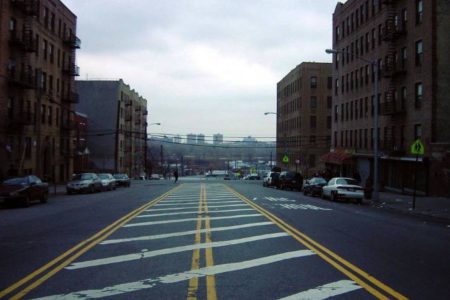Environmental Protection Commissioner Cas Holloway today announced the operation of enhanced treatment measures to reduce the amount of nitrogen being discharged into the East River at the Hunts Point Wastewater Treatment Plant in the Bronx.
The installation of biological nitrogen removal technology at the plant will reduce nitrogen discharges at the plant by 45%, from 22,000 pounds per day to 12,000 pounds per day. This phase of work cost $280 million, and a second $20 million phase will reduce nitrogen discharges by an additional 7,000 pounds per day by 2014. DEP is investing an additional $770 million in nitrogen reduction measures at the other three Upper East River wastewater treatment plants: Bowery Bay, Tallman Island and Wards Island. These projects are scheduled to be complete in 2012, and will reduce total nitrogen discharges into the East River by more than 52%. Commissioner Holloway was joined at the announcement by Council Member Maria del Carmen Arroyo and Eric Goldstein of the Natural Resources Defense Council at the Hunts Point Wastewater Treatment Plant.
“The East River and Long Island Sound are vital natural resources for all New Yorkers and the investments we are making at our East River wastewater treatment plants will immediately improve water quality in these waterways,” said Commissioner Holloway. “Years of steady and committed work to improve our treatment plants have already had measurable effects. Today, our harbor water quality is the best it has been in 100 years and New York City is now meeting monthly secondary treatment standards for the first time ever. Improved water quality means more opportunities for New Yorkers to enjoy our waterfront—a critical component of PlaNYC, Mayor Bloomberg’s blueprint for a sustainable city.”
“I applaud the DEP’s continued efforts to reduce the amounts of nitrogen discharged into our waterways,” said Bronx Borough President Ruben Diaz Jr. “It is essential that we work together to minimize and eventually eliminate the impact of our wastewater treatment process on the local environment. The DEP’s commitment to clean up the East River combined with the efforts of many of our local organizations, as well as that of my office, to reduce stormwater runoff and minimize water pollution in the Bronx will result in cleaner, healthier aquatic ecosystems and an attractive waterfront for all to enjoy.”
Although it is not a pathogen and poses no risk to human beings, high levels of nitrogen can degrade the overall ecology of a waterway. They can lead to reduced levels of dissolved oxygen in waterways and excessive algae growth, especially in warm weather months.
The western end of Long Island Sound funnels into a narrow area bounded by lower Westchester, western Nassau, and the Bronx and northern Queens. The waters of the East River and Long Island Sound are periodically impacted by algae blooms, which can sometimes grow to several miles in area. These blooms depress the amounts of dissolved oxygen in the Sound, impairing the survival of fish and other marine organisms. Algal colonies propagate from sunlight and nutrients, such as nitrogen. The primary sources of nitrogen in the Sound are wastewater treatment facilities that serve more than a dozen municipalities along the Connecticut and New York coasts.
DEP’s wastewater treatment plants were not originally designed to remove nitrogen, a naturally-occurring component in all wastewater. Currently, the 786 million gallons of daily wastewater handled by the six wastewater treatment plants on the East River result in the discharge of approximately 96,000 pounds of nitrogen each day. The six wastewater treatment plants located on the East River are: Newtown Creek, Red Hook, Bowery Bay, Tallman Island, Wards Island, and Hunts Point.
In total, DEP will spend more than $1 billion by 2016 to reduce nitrogen discharges to all New York waterways by more than 60,000 pounds per day. The project at the Hunts Point plant includes modifications and upgrades to the treatment processes, so that the ammonia-nitrogen in wastewater will now be converted to nitrogen gas. Both chemical and biological systems are used to do this, including a process that cultivates a naturally-occurring bacteria that metabolizes ammonia.
Last November, DEP announced the use of a new technology to remove nitrogen from wastewater, which is being used at the Wards Island Wastewater Treatment Plant in Manhattan. The technology, patented as the SHARON (Single Reactor System for High Rate Ammonia Removal Over Nitrate) Process, has the ability to quickly break down ammonia nitrogen at less cost and with a smaller carbon footprint than traditional technologies. The SHARON system is expected to reduce the discharges of nitrogen into Long Island Sound by more than 10,000 pounds per day. The City is also investing $100 million to install new nitrogen control technologies at wastewater treatment plants located on Jamaica Bay. In June, DEP announced the launch of the first phase of enhanced treatment measures to reduce the amount of nitrogen being discharged into Jamaica Bay at 26th Ward Wastewater Treatment Plant. The installation of biological nitrogen removal technology at the plant will reduce nitrogen discharges by more than 4,000 pounds per day, or 10% of the total nitrogen discharges from treatment plants into the bay, until additional investments are completed by 2014. These investments, made in concert with $95 million the City already has committed for nitrogen control upgrades, will reduce the nitrogen loads discharged into Jamaica Bay by nearly 50% over the next ten years.
In addition to the nitrogen-removal upgrade at the Hunts Point plant, odor controls have been extensively upgraded, with the consolidation within a single building of all off-site residual materials. The new Residuals Handling Building includes large carbon absorbers that filter odorous air.
The Hunts Point Wastewater Treatment Plant began operating in 1952 and is designed to treat up to 200 million gallons of wastewater a day from approximately 684,000 residents from the eastern section of the Bronx. Approximately 108 sewage treatment workers, engineers and other DEP personnel work at the plant. New Yorkers produce, and DEP treats, more than 1.3 billion gallons of wastewater every day. The wastewater is collected through 7,400 miles of lateral sewers that flow downhill into large interceptor sewers, which lead directly to the City’s 14 wastewater treatment plants.
Mayor Bloomberg has made investing in the City’s infrastructure a top priority. Since 2002, the City has invested more than $5 billion in upgrading its 14 wastewater treatment plants. That work has already yielded benefits for New York’s waterways, which are the cleanest they have been in 100 years since the City has began collecting water quality data in New York Harbor. DEP also is reaching City-wide monthly average Clean Water Act secondary treatment standards for the first time ever – three years ahead of schedule.
DEP manages the City’s water supply, providing more than 1 billion gallons of water each day to more than 9 million residents, including 8 million in New York City. New York City’s water is delivered from a watershed that extends more than 125 miles from the City, and comprises 19 reservoirs, and three controlled lakes. Approximately 7,000 miles of water mains, tunnels and aqueducts bring water to homes and businesses throughout the five boroughs, and 7,400 miles of sewer lines take wastewater to 14 in-City treatment plants.







